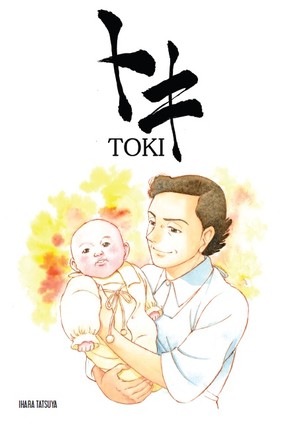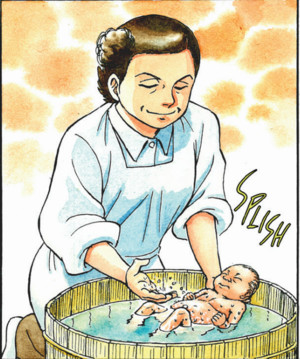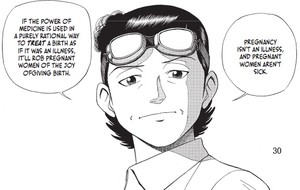The Spring 2024 Manga Guide
Toki
What's It About?

Toki has a story and art by Tatsuya Ihara. English translation by Dan Luffey. This volume is lettered by Aidan Clarke, and published by Star Fruit Books (May 21, 2024).
Is It Worth Reading?

Rating: When I was in labor with my son, his heart rate kept dropping dangerously low. When he was born a few minutes later, it turned out that his umbilical cord was wrapped around his neck! (He's fine.) Though I know that many pregnant people opt for home births, I was grateful to be in a hospital just in case something went wrong—and it nearly did. Toki is a manga about a time before hospital births were the norm. When something went wrong during delivery, it was up to the midwife to use her wits and experience to help the mother and baby survive.
Toki is about the titular protagonist, a small village's only midwife, practicing her trade in the 1950s. At the time, the manga informs us, the American occupation was beginning to force American medical standards onto Japanese people—including hospital births. Toki disapproves of this because some 1950s gynecological practices, like cutting the perineum to make delivery easier for doctors, were obviously bad for pregnant people. But Toki fails to acknowledge that modern medical practices aren't all bad.
Though all's well that ends well in this book (fortunately, I do not have to include a content warning for dead babies!) the book's climax features Toki delivering a difficult twin birth that even she admits ought to have been a hospital C-section. This slim 54-page volume is packed with pathos. When Toki delivered the twins, I was on the edge of my seat. When she used a very old-fashioned and silly-looking practice to get the baby's heart pumping, I laughed so hard I cried. It was the result of a very scary moment followed by a sudden relief of that tension.
This manga may be all about gynecology, but it was created by a manga artist, not a doctor, about the real-life version of Toki: his midwife grandmother. Perhaps that is why some of its “facts” gave me serious side-eye, like the idea that amniotic fluid is like the ocean and “most” babies are born around the full moon. Even so, it's an interesting glimpse into a part of history that doesn't often get the manga treatment.

Rating:
I'm not sure how an obstetrician, midwife, doula, or person who has given birth would feel about this dense fifty-page manga, but from a historical perspective, specifically a women's history point of view, it is fascinating. Taking place in 1959, it tells a brief moment in midwife Toki's life as she faces the changes in post-war Japan's medical system that will eventually phase out traditional midwifery and move to a medicalization of birth. Toki is helping to train a young woman who falls under the new designation of obstetrics nurse, and Toyoda is fascinated by the emphasis on the natural way Toki helps mothers bring new life into the world. When the birth she's assisting with comes out significantly less bloody than those she's used to seeing in the hospital, she realizes that every birth she's observed in a hospital setting has made use of an episiotomy (cutting the perineum to widen the vagina) for the convenience of the doctors, not the mothers. Toki instead presses on the perineum, trying to keep things more comfortable while still helping the baby out of the birth canal.
Toki muses about the changing landscape of her world through what she's experienced over her lifetime and how that influences her work. She was a child in Tokyo during the Great Kanto Earthquake, her husband died in World War Two, and now she's about to become a grandmother for the first time – as she frames it, the water in the river keeps on moving. She's carried along but not fighting or resisting change; it's just a part of life. As long as she can keep bringing new life into the world, she will be okay. It's a gently philosophical work celebrating women's history through the lens of childbirth, reminding us that it's not easy or comfortable, but worth it in the end to keep moving ahead. Toki worries about the medicalization of birth as something that will push it out of women's sphere, and that feels valid; my mother was born on an airplane and was the first of my grandmother's children where she was awake for the process, and it was a real shock to her. Not that birth is a pretty or simple process, but it was one that the medical establishment kept her largely unaware of, and it feels like that's what Toki is worried about. But instead of fighting, she'll do her best as long as she can. Life has taught her that nothing stays the same.
Toki packs a lot into a scant fifty pages. A photograph in the back of the book implies that it may be based on the creator's grandmother, and I think that adds even more to the work. It's a piece of history that is often neglected if you're not a medical professional (shows like Call the Midwife notwithstanding), but one that we really ought to be thinking about, and Toki does a beautiful job of allowing us to do just that.
discuss this in the forum (16 posts) |
back to The Spring 2024 Manga Guide
Seasonal homepage / archives